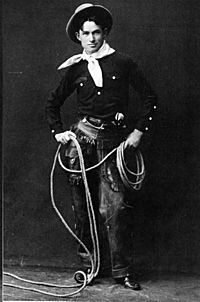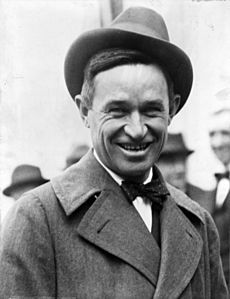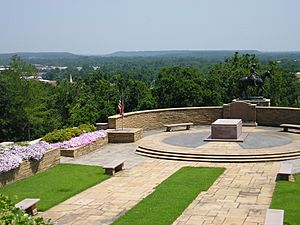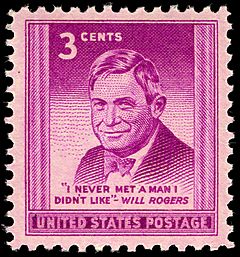Will Rogers facts for kids
Quick facts for kids
Will Rogers
|
|
|---|---|
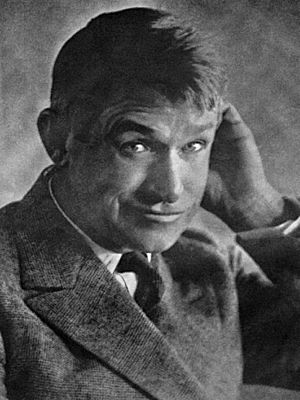
Rogers in 1922
|
|
| Honorary Mayor of Beverly Hills | |
| In office 1926–1926 |
|
| Personal details | |
| Born |
William Penn Adair Rogers
November 4, 1879 Oologah, Indian Territory |
| Died | August 15, 1935 (aged 55) Point Barrow, Alaska Territory, U.S. |
| Cause of death | Airplane crash |
| Resting place | Will Rogers Memorial in Claremore, Oklahoma |
| Nationality | Cherokee Nation United States |
| Political party | Democratic |
| Spouse |
Betty Blake
(m. 1908) |
| Children | 4, including Will Rogers Jr. and James Blake Rogers |
| Occupation | Actor, vaudevillian, cowboy, columnist, humorist, radio personality |
William Penn Adair Rogers (born November 4, 1879 – died August 15, 1935) was a famous American performer, actor, and funny commentator. He was born into the Cherokee Nation in what is now Oklahoma. Many people called him "Oklahoma's Favorite Son".
Will traveled the world three times. He made 71 movies, including 50 silent films and 21 "talkies" (movies with sound). He also wrote over 4,000 newspaper columns that appeared all over the country. By the mid-1930s, Will Rogers was very popular in the United States. He was known for his clever political jokes. He was also the highest-paid movie star in Hollywood. Will Rogers died in 1935 with pilot Wiley Post when their small plane crashed in northern Alaska.
Rogers started his career performing in vaudeville shows. His amazing rope tricks helped him succeed in the Ziegfeld Follies. This led to his first movie deals. His newspaper columns and radio shows in the 1920s made him even more famous. Will Rogers also strongly supported the growth of aviation. He shared stories from his world travels with Americans. His simple stories and friendly style allowed him to joke about many topics. He made fun of gangsters, prohibition, politicians, and government programs. People across the country loved his humor. His funny sayings were often repeated, like: "I am not a member of an organized political party. I am a Democrat."
Contents
Will Rogers' Early Life
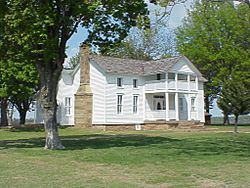
Will Rogers was born on his parents' Dog Iron Ranch. This was in the Cherokee Nation, near where Oologah, Oklahoma is today. The county, Rogers County, is named after his father, Clem Vann Rogers. The house where Will was born was built in 1875. It was known as the "White House on the Verdigris River".
His parents, Clement Vann Rogers (1839–1911) and Mary America Schrimsher (1838–1890), were both part Cherokee. They identified as Cherokee. Will Rogers once joked that his ancestors did not come over on the Mayflower. Instead, they "met the boat." His mother was one-quarter Cherokee. She died when Will was eleven years old. His father remarried less than two years later.
Will was the youngest of eight children. He was named after the Cherokee leader Col. William Penn Adair. Only three of his sisters, Sallie Clementine, Maude Ethel, and May, lived to be adults.
His father, Clement, was an important leader in the Cherokee Nation. He was a lawyer and a Cherokee judge. He also fought in the Confederate army. He helped write the Oklahoma Constitution. Rogers County, Oklahoma is named in his honor. He also served many terms in the Cherokee Senate.
Will Rogers and his father had a difficult relationship when Will was young. Clement wanted his son to be more serious and business-minded. Will was more relaxed and enjoyed his mother's love. Their personalities clashed, especially after his mother died when he was eleven. Young Will tried many different things but did not find much success. The relationship only started to get better after Will became famous in vaudeville. His father died in 1911, so they never fully made up.
Will Rogers went to school in Indian Territory. He attended Willie Halsel College in Vinita in 1895 and 1896. Then he went to Kemper Military School in Boonville, Missouri from 1897 to 1898. He was a good student and loved reading The New York Times. However, he dropped out of school after the 10th grade. Rogers later said he was a poor student. He joked that he "studied the Fourth Reader for ten years." He was much more interested in cowboys and horses. He learned how to rope and use a lariat.
Will Rogers' First Jobs
In 1899, Rogers performed at the St. Louis Fair as part of the Mulhall Rodeo. In late 1901, when he was 22, he and a friend left home. They hoped to work as gauchos in Argentina. They arrived in Argentina in May 1902. They spent five months trying to be ranch owners in the Pampas. Rogers and his friend lost all their money. He later said, "I was ashamed to send home for more." The two friends went their separate ways. Rogers sailed to South Africa. It is often said he broke in horses for the British Army. However, the Second Boer War had ended three months earlier. Rogers was hired at James Piccione's ranch near Mooi River Station in Natal.
Will Rogers' Career
Rogers left the circus and went to Australia. He had a letter of recommendation for the Wirth Brothers Circus there. Rogers continued to perform as a rider and trick roper. He also worked on his pony act. He returned to the United States in 1904. He appeared at the Saint Louis World's Fair. Then he started trying his roping skills in vaudeville shows.
Vaudeville Performer
Will Rogers was in New York City on April 27, 1905. He was at Madison Square Garden. A wild steer broke out of the arena and started to climb into the seats. Rogers roped the steer, and the crowd loved it. This act made front-page news. It gave him great publicity and an audience eager to see more. Willie Hammerstein saw his vaudeville act. He hired Rogers to perform on the Victoria Roof, which was literally on a rooftop, with his pony. For the next ten years, Rogers worked about 50 weeks a year at the Roof and other vaudeville theaters in the city.
Rogers later remembered these early years:
- I got a job on Hammerstein's Roof at $140 a week for myself, my horse, and the man who looked after it. I remained on the roof for eight weeks, always getting another two-week extension when Willie Hammerstein would say to me after the Monday matinee, 'you're good for two weeks more'... Marty Shea, the booking agent for the Columbia, came to me and asked if I wanted to play burlesque. They could use an extra attraction....I told him I would think about it, but 'Burlesque' sounded to me then as something funny." Shea and Sam A. Scribner, the general manager of the Columbia Amusement Company, approached Rogers a few days later. Shea told Scribner Rogers was getting $150 and would take $175. "'What's he carrying?', Scribner asked Shea. 'Himself, a horse, and a man', answered Shea." Scribner replied, "'Give him eight weeks at $250'".
In the fall of 1915, Rogers began performing in Florenz Ziegfeld's Midnight Frolic. This variety revue started at midnight. It was in the top-floor nightclub of Ziegfeld's New Amsterdam Theatre. Many important and regular customers came to see it. By this time, Rogers had perfected his act. His talks about the daily news followed a similar routine every night. He came on stage in his cowboy outfit, casually twirling his lasso. He would say, "Well, what shall I talk about? I ain't got anything funny to say. All I know is what I read in the papers." Then he would tell jokes about what he had read in that day's newspapers. The line "All I know is what I read in the papers" is often mistakenly called his most famous punch line. But it was actually his opening line.
His shows at the New Amsterdam continued into 1916. Rogers's growing popularity led to a role in the more famous Ziegfeld Follies. At first, Rogers's act was only physical. It was a silent show of daring riding and clever lasso tricks. He realized that audiences saw the cowboy as the perfect American. This idea was helped by Theodore Roosevelt's image as a cowboy. Rogers's cowboy was a free man, not controlled by rules or officials. When he returned to the United States and worked in Wild West shows, he slowly started adding spoken jokes. For example, he would say, "Swingin' a rope's all right... if your neck ain't in it." Audiences loved his quiet but sharp humor. They were also fascinated by his Oklahoma accent. By 1916, Rogers was a featured star in Ziegfeld's Follies on Broadway. He changed from the "Ropin' Fool" to the "Talkin' Fool." At one show, with President Woodrow Wilson in the audience, Rogers made up jokes about the president's policies. Wilson and the whole audience laughed a lot. This showed his amazing skill at quick, funny comments on current events. He built the rest of his career around this talent.
A 1922 editorial in The New York Times said that "Will Rogers in the Follies is carrying on the tradition of Aristophanes, and not unworthily." Rogers also started making silent films for Samuel Goldwyn's company Goldwyn Pictures. He made his first silent movie, Laughing Bill Hyde (1918), in Fort Lee, New Jersey. Many early films were made in the New York area back then. Rogers could make a film and still easily rehearse and perform in the Follies. He appeared in most of the Follies from 1916 to 1925.
Will Rogers' Film Career
Hollywood discovered Rogers in 1918. Samuel Goldwyn gave him the main role in Laughing Bill Hyde. A three-year contract with Goldwyn, paying him three times his Broadway salary, moved Rogers west. He bought a ranch in Pacific Palisades. He also started his own film company. Rogers enjoyed acting in films. However, his silent movie performances were limited because he was famous for his spoken humor on stage. He wrote many of the title cards (text shown between scenes) in his films. In 1923, he worked for Hal Roach for one year and made 12 movies. Among the films he made for Roach in 1924 were three directed by Rob Wagner: Two Wagons Both Covered, Going to Congress, and Our Congressman. He made two other silent feature films and a travel series in 1927. After that, he did not return to the screen until he started working in "talkies" (movies with sound) in 1929.
Rogers made 48 silent movies. But when sound came to films in 1929, he became a top star. His first sound film, They Had to See Paris (1929), gave him the chance to use his verbal wit. He played a simple farmer in State Fair (1933). He was an old-fashioned doctor in Dr. Bull (1933). He played a small-town banker in David Harum (1934). He was also a country politician in Judge Priest (1934). He also appeared in County Chairman (1935), Steamboat Round the Bend (1935), and In Old Kentucky (1935). His favorite director was John Ford.
Rogers appeared in 21 feature films. He acted alongside famous performers like Lew Ayres, Billie Burke, Richard Cromwell, Jane Darwell, Andy Devine, Janet Gaynor, Rochelle Hudson, Boris Karloff, Myrna Loy, Joel McCrea, Hattie McDaniel, Ray Milland, Maureen O'Sullivan, ZaSu Pitts, Dick Powell, Bill "Bojangles" Robinson, Mickey Rooney, and Peggy Wood. He was directed three times by John Ford. He appeared in four films with his friend Stepin Fetchit (also known as Lincoln T. Perry): David Harum (1934), Judge Priest (1934), Steamboat Round the Bend (1935), and The County Chairman (1935).
As his voice became more familiar to audiences, Rogers mostly played himself in each film. He did not use film makeup. He often added jokes and his usual comments on politics. His films had a clean, moral tone. Because of this, many public schools took their classes to special showings during the school day. His most unusual role might have been in the first talking version of Mark Twain's novel A Connecticut Yankee in King Arthur's Court. His popularity grew even more with films like Young As You Feel, Judge Priest, and Life Begins at 40.
Newspapers and Radio Shows
Rogers was a very hard worker. He toured giving lectures. The New York Times published his weekly newspaper column from 1922 to 1935. Starting in 1926, his short column "Will Rogers Says" reached 40 million newspaper readers daily. He also wrote often for the popular magazine The Saturday Evening Post. Rogers told Americans to value friendliness and democracy at home. He also advised them to stay out of foreign conflicts. He strongly supported aviation, including a military air force. His flying friend General Billy Mitchell also supported this idea.
Rogers started a weekly column called "Slipping the Lariat Over" in late 1922. He had already published a book of jokes. He then began a steady stream of humor books. Through his columns for the McNaught Syndicate between 1922 and 1935, and his live shows and radio broadcasts, he won the love of the American people. He made witty jokes about the issues of the day and important people, often politicians. He wrote from a neutral point of view. He became friends with presidents and a trusted person for important figures. People loved him for his calm mind and kind heart. He was often seen as the next great humorist after people like Artemus Ward and Mark Twain. Rogers was not the first entertainer to use political humor. Others, like Broadway comedian Raymond Hitchcock and Britain's Sir Harry Lauder, did so years before him. Bob Hope is the most famous political humorist to follow Rogers's example.
Radio was an exciting new medium. Rogers became a star there too, reading his newspaper pieces. From 1929 to 1935, he broadcast for the Gulf Oil Company. This weekly Sunday evening show, The Gulf Headliners, was one of the top radio programs in the country. Rogers often talked freely, moving from one topic to another. He would react to his studio audience. In his early broadcasts, he often lost track of the half-hour time limit. He would be cut off in the middle of a sentence. To fix this, he brought a wind-up alarm clock. Its buzzing on the air told him to start finishing his comments. By 1935, his show was announced as "Will Rogers and his Famous Alarm Clock."
Will Rogers' Personal Life
In 1908, Rogers married Betty Blake (1879–1944). They had four children: Will Rogers Jr., Mary Amelia, James Blake, and Fred Stone. Will Jr. became a hero in World War II. He played his father in two movies. He was also elected to Congress. Mary became a Broadway actress. James "Jim" was a newspaperman and rancher. Fred died of diphtheria at age two. The family lived in New York. However, they spent summers in Oklahoma. In 1911, Rogers bought a 20-acre (8.1 ha) ranch near Claremore, Oklahoma. He planned to use it as his retirement home. He paid US$500 an acre.
From about 1925 to 1928, Rogers traveled all over the United States on a "lecture tour." He started his lectures by saying, "A humorist entertains, and a lecturer annoys." During this time, he became the first civilian to fly from coast to coast. He flew with pilots who delivered mail on early air mail flights. The National Press Club called him "Ambassador at Large of the United States." He visited Mexico City with Charles Lindbergh. They were guests of U.S. Ambassador Dwight Morrow. Rogers gave many after-dinner speeches. He became a popular speaker at conventions. He also gave dozens of benefit shows to help victims of floods, droughts, or earthquakes.
Rogers traveled to Asia to perform in 1931. He went to Central and South America the next year. In 1934, he made a trip around the world. He then returned to play the lead in Eugene O'Neill's play Ah, Wilderness!. He had thought about starring in the 1935 movie version of the play. However, he was worried about how fans would react to a "facts-of-life" talk in the movie. So, he turned down the role. He and Wiley Post then planned to fly to Alaska that summer.
Will Rogers' Views on Politics
Rogers was a Democrat. However, he was known for not being strongly tied to one political party. He was friends with every president starting with Theodore Roosevelt. He famously supported Republican Calvin Coolidge over John W. Davis in 1924. During the Republican Convention of 1928, Rogers joked about the party's plans. But he welcomed the nomination of Kaw citizen Charles Curtis as vice president. He felt the party leaders had kept Curtis from becoming president. He said, "The Republican Party owed him something, but I didn’t think they would be so low down as to pay him that way." Four years later, Republican leaders tried to remove Curtis from the ticket. Rogers defended him. He took credit for keeping him on the ticket: "I saved my 'Injun' Charley Curtis for vice presidency. The rascals was just ready to stab him when we caught ‘em."
In 1932, Rogers supported Democrat Franklin D. Roosevelt. Roosevelt was his favorite president and politician. Rogers supported Roosevelt's New Deal programs. But he could also joke about them: "Lord, the money we do spend on Government and it's not one bit better than the government we got for one-third the money twenty years ago."
Rogers served as a goodwill ambassador to Mexico. He also had a short time as mayor of Beverly Hills. This was mostly a ceremonial job. It allowed Rogers to joke about politicians who did not do much, like himself. During the worst part of the Great Depression, he was angry that Washington could not feed the people. He went on a tour across the country to raise money for the Red Cross.
Will Rogers' 1928 Presidential Campaign
Rogers thought all political campaigning was silly. To prove his point, he ran a fake campaign for president in 1928. His only platform was the pages of Life, a weekly humor magazine. The campaign was mostly an effort to sell more magazines. Rogers ran as the "bunkless candidate" of the Anti-Bunk Party. His campaign promise was that if elected, he would resign. Every week, from Memorial Day to Election Day, Rogers made fun of the serious and often ridiculous parts of political campaigns. On election day, he declared victory and resigned. (He did not actually receive any state electoral votes.)
Will Rogers' Philosophy and Style
After Rogers became known as a humorist and philosopher in vaudeville, he gained a national audience in acting and writing from 1915 to 1935. During these years, Rogers increasingly shared the views of the "common person" in America. He did not think much of academic degrees. He noted, "Everybody is ignorant, only on different subjects." Americans from all walks of life admired his independence. They liked his belief in democratic ideas and his open-minded views on most issues. Rogers also praised hard work as a way to succeed. These ideas supported American beliefs about how to achieve personal success. Rogers represented the self-made man, the common person, who believed in America, in progress, and in the American Dream of moving up in life. His humor never offended even those he joked about.
In the 1920s, the United States was happy and rich in many ways. This time was called the Roaring Twenties. But it also had fast changes and social tensions. Some people felt unhappy and disconnected from the outside world. Many ordinary people believed that World War I had caused a lot of senseless killing. They supported the US staying out of other countries' problems (isolationism). According to scholar Peter Rollins (1976), Rogers seemed like a steady anchor. His normal home life and traditional moral values reminded people of a recent past. His newspaper column, which ran from 1922 to 1935, showed his traditional morals. It also showed his belief that political problems were not as serious as they sounded. In his films, Rogers started by playing a simple cowboy. His characters grew to explore what innocence meant in everyday life. In his last movies, Rogers looked at a society breaking apart into different classes due to money problems. Throughout his career, Rogers was a link to a better, easier-to-understand past.
In 1926, the popular weekly magazine The Saturday Evening Post paid for Rogers to tour Europe. In return, they published his articles. Rogers made quick visits to many European capitals. He met both international leaders and ordinary people. His articles showed a fear that Europeans would go to war again. He suggested that the United States should stay out of foreign affairs (isolationism). He believed that for now, America's needs would be best met by focusing on problems at home and avoiding foreign conflicts. He commented:
- America has a unique record. We never lost a war and we never won a conference in our lives. I believe that we could without any degree of egotism, single-handed lick any nation in the world. But we can't confer with Costa Rica and come home with our shirts on.
Rogers was famous for how he used language. He used current slang effectively. He also made up new words when he needed them. He often used puns and terms that connected him to the cowboy tradition. He also used speech patterns with a southern accent.
Will Rogers' Aviation Advocacy and Death
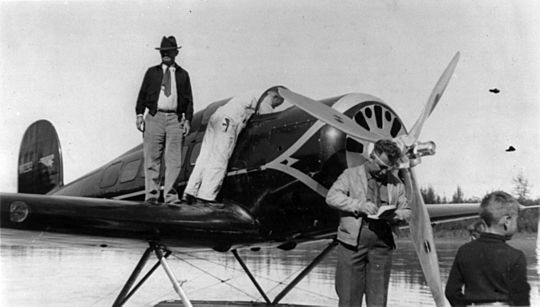
Will Rogers became a supporter of the aviation industry. He noticed how much aviation had grown in Europe. He also became friends with Charles Lindbergh, the most famous American pilot of that time. During his 1926 trip to Europe, Rogers saw how advanced commercial air travel was there. He compared it to the almost non-existent facilities in the United States. Rogers' newspaper columns often highlighted how safe, fast, and convenient air travel was. He helped shape public opinion on the topic.
In 1935, the famous pilot Wiley Post, who was also from Oklahoma, wanted to map out a mail and passenger air route from the West Coast to Russia. He put a Lockheed Explorer wing on a Lockheed Orion plane body. He added floats so it could land on lakes in Alaska and Siberia. Rogers often visited Post at the airport in Burbank, California, while he was changing the plane. He asked Post to fly him through Alaska. He hoped to find new material for his newspaper column.
After a test flight in July, Post and Rogers left Lake Washington in Renton in early August. They were in the Lockheed Orion-Explorer. They made several stops in Alaska. While Post flew the plane, Rogers wrote his columns on his typewriter. Before they left Fairbanks, they signed and mailed a burgee (a special flag) belonging to the South Coast Corinthian Yacht Club. This signed flag is now on display at the South Coast Corinthian Yacht Club in Marina del Rey, California. On August 15, they left Fairbanks for Point Barrow.
About 20 miles southwest of Point Barrow, they had trouble figuring out their location due to bad weather. They landed in a lagoon to ask for directions. On takeoff, the engine failed at a low height. The plane crashed into the lagoon, breaking off the right wing. It ended up upside down in the shallow water. Both men died instantly. Rogers was buried on August 21, 1935, in Forest Lawn Park in Glendale, California. This was a temporary burial. He was later reburied at the Will Rogers Memorial in Claremore, Oklahoma.
Experts have studied what caused the accident. They still disagree about it. Bobby H. Johnson and R. Stanley Mohler wrote in a 1971 article that Post had ordered floats that did not arrive in Seattle in time. He used a set designed for a larger plane. This made the plane, which was already heavy in the front, even more so. But Bryan and Frances Sterling wrote in their 2001 book Forgotten Eagle: Wiley Post: America's Heroic Aviation Pioneer that their research showed the floats were the correct type for the aircraft. This suggests another reason for the crash.
Will Rogers' Legacy
In 1962, the town of Higgins, Texas (near a ranch where Rogers had worked in 1922), started an annual Will Rogers Day. This honored the cowboy philosopher, who remained a close friend of Frank Ewing, the son of his old boss.
Rogers was later added to the National Aviation Hall of Fame in Dayton, Ohio.
Oklahoma Honors Will Rogers
Before he died, the state of Oklahoma ordered a statue of Rogers. It was to be one of two statues from Oklahoma in the National Statuary Hall Collection at the United States Capitol. Rogers agreed, but only if his statue faced the House Chamber. He supposedly wanted to "keep an eye on Congress." Of the statues in this part of the Capitol, Rogers's sculpture is the only one facing the Chamber entrance. It is a common spot for camera crews to film House members. It is also a frequent background for reporters and lawmakers. Staff often tell the media to be at the "Will Rogers stakeout" at a certain time. Some Capitol guides say that each U.S. president rubs the left shoe of the Rogers statue for good luck. They do this before entering the House Chamber to give the State of the Union address.
The state paid for the statue. It was sculpted in clay by Jo Davidson. He had been a close friend of Rogers. Davidson had the work cast in bronze in Brussels, Belgium. The statue was dedicated on June 6, 1939. Over 2,000 people attended. It faces the entrance to the House of Representatives Chamber next to National Statuary Hall. The Architect of the Capitol, David Lynn, said there had never been such a large ceremony or crowd in the Capitol.
His birthplace, the Dog Iron Ranch, is two miles east of Oologah, Oklahoma. When the Verdigris River valley was flooded to create Oologah Lake for a large dam project, Rogers's house was saved. It was moved about ¾ mile (1.2 km) to its current spot overlooking the original site.
The family tomb is at the Will Rogers Memorial Museum. This museum was built in nearby Claremore on the land Rogers bought in 1911 for his retirement home. On May 19, 1944, Rogers's body was moved from a temporary vault in Glendale, California, to the tomb. After his wife Betty died later that year, she was also buried there. A copy of the Davidson sculpture from National Statuary Hall, paid for by Davidson, was placed at the museum. Both his birthplace and the museum are open to the public.

Many places were named in Rogers' honor: Will Rogers World Airport in Oklahoma City. A recent expansion there included a statue of Rogers on horseback in front of the terminal. The Will Rogers Turnpike is the part of Interstate 44 between Tulsa and Joplin, Missouri. Near Vinita, Oklahoma, a statue of Rogers was placed at the service plaza that goes over the interstate.
Thirteen public schools in Oklahoma have been named for Rogers. This includes Will Rogers High School in Tulsa. The University of Oklahoma named the large Will Rogers Room in the student union after him. The Boy Scouts of America honored him with the Will Rogers Council and the Will Rogers Scout Reservation near Cleveland.
In 1947, a college football bowl game was named in his honor. However, the event stopped after the first year.
The Academy of Western Artists, based in Gene Autry, Oklahoma, gives out an annual Will Rogers Medallion award. This award recognizes excellence in western literature.
Colorado Memorial
The Will Rogers Shrine of the Sun is an 80-foot observation tower. It is on Cheyenne Mountain west of Colorado Springs. It is at the base of Pikes Peak near the Cheyenne Mountain Zoo.
California Memorials

Rogers's California home, stables, and polo fields are now preserved. They are open to the public as Will Rogers State Historic Park in Pacific Palisades. His widow, Betty, gave the property to the state of California when she died in 1944. She had one condition: polo must be played on the field every year. It is now home to the Will Rogers Polo Club.
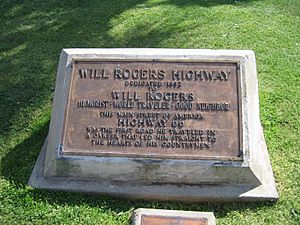
Several schools have been named for him: Will Rogers Elementary School in Santa Monica, Will Rogers Elementary School in Ventura, and middle schools in Long Beach and in Fair Oaks.
Will Rogers Memorial Park, a small park at Sunset Boulevard and Beverly Drive in Beverly Hills, was named after him. So was Will Rogers State Beach in the Pacific Palisades.
U.S. Route 66 is known as the Will Rogers Highway. A plaque dedicating the highway to the humorist is at the western end of Route 66 in Santa Monica.
The California Theatre in San Bernardino was the site of the humorist's final show. He always performed in front of special jeweled curtains. He had two of them. While he used one, he would send the other to the location of his next performance. The curtain used in his final show was kept by the California Theatre. Two memorial murals by Kent Twitchell were placed on the outside of the fly loft. The California Theatre named one of its reception rooms the Will Rogers Room.
Texas Memorials
The Will Rogers Memorial Center was built in Fort Worth, Texas, in 1936. It includes a mural, a bust, and a life-size statue of Will Rogers on his horse Soapsuds. This statue is called Riding into the Sunset. It was sculpted by Electra Waggoner Biggs.
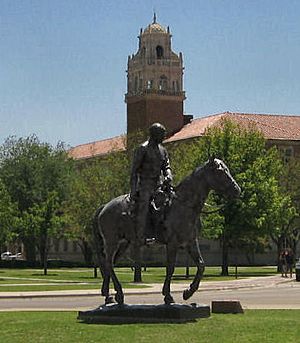
A copy of Riding into the Sunset stands at the entrance to the main campus quad at Texas Tech University in Lubbock, Texas. This memorial was dedicated on February 16, 1950, by Rogers' long-time friend, Amon G. Carter. Another copy is at the Will Rogers Memorial in Claremore. A third copy is at the entrance of the Hilton Anatole in Dallas.
Washington State and Alaska Memorials
A small monument at the Renton airport remembers the starting point of the fatal 1935 flight of Post and Rogers. A memorial is also located in the city of Utqiagvik (formerly Barrow), Alaska.
National Tributes to Will Rogers
In 1936, the NVA Hospital in Saranac Lake, New York was renamed the Will Rogers Memorial Hospital. This was done by the National Vaudeville Artists association.
On November 4, 1948, the United States Post Office honored Rogers with a three-cent postage stamp. In 1979, it issued a United States Postal Service 15-cent stamp of him. This was part of the "Performing Arts" series.
In 1976, Rogers was among the historical figures shown in the artwork Our Nation's 200th Birthday, The Telephone's 100th Birthday by Stanley Meltzoff for Bell System.
The Barrow, Alaska airport (BRW) is about 16 miles (26 km) from where the fatal airplane crash happened. It is known as the Wiley Post–Will Rogers Memorial Airport.
The Rogers-Post Site, overlooking the lagoon where the plane crashed, has two (or possibly one remaining) monuments. It is on the National Register of Historic Places. A plaque to Rogers and Post was also put up in Barrow.
The World War II Liberty Ship SS Will Rogers was named in his honor.
The last ship of the Benjamin Franklin-class submarines, USS Will Rogers (SSBN-659), was launched in 1966. It was put into service the following year.
On November 4, 2019, Google celebrated his 140th birthday with a Google Doodle.
Film and Stage Portrayals of Will Rogers
Rogers was played by A.A. Trimble in small roles in the 1936 film The Great Ziegfeld and the 1937 film You're a Sweetheart.
Rogers was played by his son, Will Rogers Jr., in a small role in the 1949 film Look for the Silver Lining. His son also starred as him in the 1952 film The Story of Will Rogers.
James Whitmore played Rogers in eight runs of the one-man play Will Rogers' USA between 1970 and 2000. This included a short run on Broadway in 1974. It was also made into a television film in 1972. Whitmore changed the monologue each time he performed it. He used quotes from Rogers to comment on current events at the time of the performance.
The Tony Award-winning musical The Will Rogers Follies was produced on Broadway in 1991. Keith Carradine played the main role. Carradine also played Rogers in the 1994 film Mrs. Parker and the Vicious Circle.
Will Rogers' Filmography
Silent Films
|
|
Travelogue Series
|
Sound Films
|
|
|
See also
 In Spanish: Will Rogers para niños
In Spanish: Will Rogers para niños
- Will Rogers phenomenon
- Will Rogers Shrine of the Sun
- Will Rogers Memorial
- Will Rogers Memorial Park
- List of people on the cover of Time Magazine: 1920s – July 19, 1926
- The Will Rogers Follies



